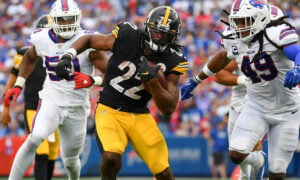Kyren Williams Through the RBPC Lens: The DLF Rookie Running Back Series

Through the coming months, I will be evaluating this year’s running backs class through the uniqueRBanalytics (RBPC) lens. This will give you a different perspective than you are used to. These will consist of a short write-up accompanied by a Four Corners Fantasy Podcast Shortcast discussing the player more in-depth. Next up is…
Kyren Williams, RB Notre Dame
- Age (For first NFL season) – 22
- Weight – 194 lbs
- Height – 69 inches
- BMI – 28.65
- 40-yard dash – 4.65
- Weight-adjusted Speed Score – 82.99
RBPC
- Profile Letter Grade – F
- Usage Designation – Hybrid+
- Receiving Upside Designation – Medium High
- Pre Draft Prospect Grade – 16.4
- Risk Rating – 2
- CFS>Avg – -12.78% (worse performer than the avg successful RB since 2005)
- Competition Grade – A-
- Average Projected Draft Capital – 5.19 (Range – Late Third ->Late Fifth)
- Age-Adjusted Athleticism – 5.467 (would be 16th-lowest drafted prospect since 2005)
- Physical Toll Grade Injury Adjustment – 2.48% (very low associated injury risk)
A Polarizing Prospect
If anyone at the running back position cost themselves a significant amount of draft capital, Kyren Williams is likely the one. And looking above, you may think how is there any way he could have had decent draft capital? He’s got an F letter-graded profile?
Here is a demonstration of how the NFL Combine altered the performance. Williams had a considerable enough advantage here that he dropped from the fourth best in the class to only sixth. This is a reflection on the class as a whole and gives us a little idea of why the class was perceived as thin.
A look at what the testing did for the performance grades of the RBs (Combine invites only sorted by per game performance/PTG – Account for usage, performance, age, athleticism, comp, injury, experience)
1/2 = Before w/ official weight (rounded)/height
3/4 = After the drills pic.twitter.com/vM73aRw1e7— David Willsey (@willson8tor) March 5, 2022
Prior to the combine, all players are graded with league-average athleticism so essentially on the same level. Now we have a better picture of who they really are.
What you see below is an example of the usage designations, what their requirements are, and how the NFL has valued them. They are pretty seamless as far as what’s required and how they are valued with the exception of the Satellite and Workhorse designations which really just shows us how much the league values versatility.

Williams met nearly every requirement to be a Bellcow Light or a Committee + designation but they both have athletic requirements he failed to achieve. Williams also meets Every requirement to have a C- letter-graded profile but again, failed to meet the athletic threshold which is not particularly high.
His performance still leaves him with a late third-round ceiling range of outcomes (as opposed to late second round). His weight of five pounds lower than listed is not as big of a deal as you may think. The range’s average draft capital for successful backs vs non-successful backs fits Williams’ projected DC range listed above (Range – Late Third ->Late Fifth).

The Risk Rating of 2 is a good look.

That F letter grade does not bode well at all historically at all though but the average draft capital for the range seems to fit with Williams’ projected draft capital.

Player History
Williams is a redshirt sophomore (early declare) who spent three years playing for the Notre Dame Fighting Irish. He posted back-to-back 200+ carry, 35+ reception, and 1,300+ total yard seasons with 31 total touchdowns – at less than 200 pounds with 4.65 speed.

Statistics from Sports Reference.
The Backfield Leader
We can see below that in 2020 and 2021, Williams owned the backfield usage for all intents and purposes. In particular, the receiving work in which he was heavily used (Market Share is a reflection of the player’s usage relative to the rest of their team/percentage of teams receptions and attempts below).


Production Vs Offensive Line Play
Williams was far from the most efficient back…

… but it is a good thing that he was >=0.5 yards per attempt more than the other RBs in 2021 when the offensive line performed poorly. At the same time, you would have expected him to be the most efficient the year prior when the line performed well in running situations. Keep in mind we are not comparing the type of deployment they had in the offense and how they were used scheme-wise.
2021

- Kyren Williams yards per attempt – 4.9
- Logan Diggs – 4.4
- Chris Tyree – 4.0
- Audric Estime – 8.6 (seven attempts)
2020

- Kyren Williams yards per attempt – 5.3
- Chris Tyree – 6.8
- C’Bo Flemister – 5.2
- Jafar Armstrong – 0.5 (17 attempts)
- Jahmir Smith – 3.0 (five attempts)
2019

The Value
Currently, on dynastyleaguefootball.com, Williams has a positional ADP (From February 22nd) of sixth and an overall ADP of 101st. This is going to change and potentially dramatically. He went from a potential mid to early second-round rookie pick or maybe even a late first to someone you may get in the third or fourth based on perception (Prior to the NFL Draft).
If he does happen to still make it in late round three or early round four as the ceiling range would suggest, you may still have to pay a mid to late second-round price. The small stature back is not in danger of going undrafted now but the chance he hits his ceiling range is very minimal. We are now likely looking at a late fourth to late fifth-round pick. Remember that he did what he did as this player the whole time.
The Kyren Williams Shortcast
Now, please enjoy this short podcast breaking down former Williams a bit more.
FCFP Shortcast – How Far Did He Fall?
Thank you for checking out the next piece in the DLF Rookie RB series. I hope you enjoyed it and found it informative. Follow along for more prospect evaluations from me (@willson8tor).



































































